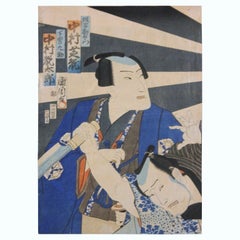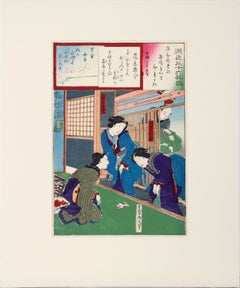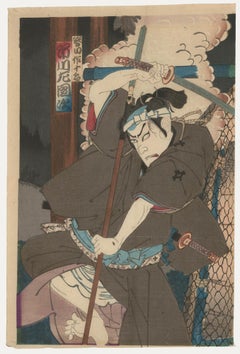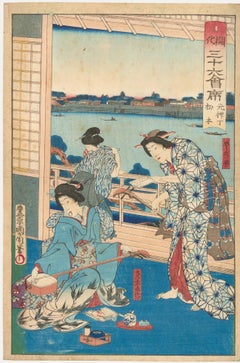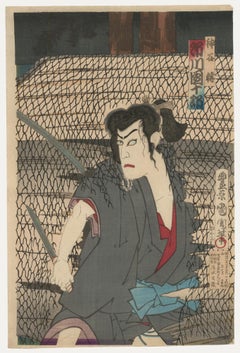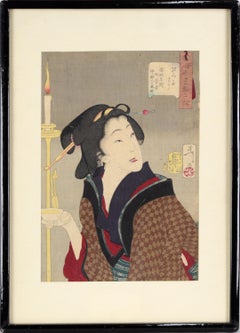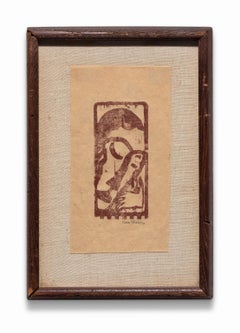Toyohara Kunichika Art
to
1
6
2
1
Overall Width
to
Overall Height
to
9
3
8
1
9
5
4
4
3
2
2
2
1
1
1
1
1
9
1
1
1
1
11
9,478
2,687
1,375
1,358
2
4
2
Artist: Toyohara Kunichika
Two Kabuki Actors Japanese Woodblock Print
By Toyohara Kunichika
Located in Houston, TX
Two kabuki actors posing a samurai's. The print is printed on rice paper and is not framed. It is stamped by the artist with details about the actors in ...
Category
1860s Edo Toyohara Kunichika Art
Materials
Woodcut
"Enshoku Sanju-roku Kasen" (Thirty-six Enchanting Flowers) Woodblock on paper
By Toyohara Kunichika
Located in Soquel, CA
"Enshoku Sanju-roku Kasen" (Thirty-six Enchanting Flowers) Woodblock on paper
Elegant woodblock print by Toyohara Kunuchika (Japanese, 1835-1900). Three women are in talking with each other inside, while a man waits outside holding a bag of some kind. The colors in this piece are rich and saturated, primarily blues, greens, and purple.
Mat size: 16"H x 20"W
Paper size: 14.75"H x 9.88"W
Born in 1835, Toyohara Kunichika grew up in the Kyobashi district of Edo in the midst of merchants and artisans. In 1848, at age 13, he was accepted as an apprentice into the studio of Utagawa Kunisada I...
Category
1880s Edo Toyohara Kunichika Art
Materials
Ink, Rice Paper, Woodcut
Toyohara Kunichika (1835-1900) - Japanese Woodblock, Kabuki Samurai II
By Toyohara Kunichika
Located in Corsham, GB
An evocative late 19th century Japanese woodblock by the master artist Toyohara Kunichika (1835-1900), depicting a Kabuki actor in the dramatic role of a fierce samurai. The composit...
Category
Late 19th Century Toyohara Kunichika Art
Materials
Woodcut
Toyohara Kunichika (1835-1900) - Woodblock, Kawacho Restaurant at Asakusa
By Toyohara Kunichika
Located in Corsham, GB
A charming Japanese woodblock print depicting three geishas playing instruments in a Kawacho restaurant. From Kaika sanjuroku kaiseki (Thirty-six famous restaurants and views of civi...
Category
Late 19th Century Toyohara Kunichika Art
Materials
Woodcut
Toyohara Kunichika (1835-1900) - Japanese Woodblock, Kabuki Samurai I
By Toyohara Kunichika
Located in Corsham, GB
An evocative late 19th century Japanese woodblock by the master artist Toyohara Kunichika (1835-1900), depicting a Kabuki actor in the dramatic role of a fierce samurai. The composit...
Category
Late 19th Century Toyohara Kunichika Art
Materials
Woodcut
Toyohara Kunichika (1835-1900) - Japanese Woodblock, Kabuki Samurai III
By Toyohara Kunichika
Located in Corsham, GB
An evocative late 19th century Japanese woodblock by the master artist Toyohara Kunichika (1835-1900), depicting a Kabuki actor in the dramatic role of a fierce samurai. The composit...
Category
Late 19th Century Toyohara Kunichika Art
Materials
Woodcut
Kabuki Scene - Woodcut by Toyohara Kunichika - Late 19th Century
By Toyohara Kunichika
Located in Roma, IT
Kabuki Scene: Teramoto Life, Death Nosuke, Sawamura Bansho is a wooduct print realized by Kunichika Toyohara (1835-1900) in the late 19th Century.
In very good condition, includes ...
Category
19th Century Modern Toyohara Kunichika Art
Materials
Woodcut
Sword Fight - Woodcut by Toyohara Kunichika - 1878
By Toyohara Kunichika
Located in Roma, IT
Sword Fight is an original artwork realized in 1878 by Kunichika Toyohara.
Color woodcut 1878.
Dimensions: 22 x 48 cm.
Actors portraits against red bac...
Category
1870s Modern Toyohara Kunichika Art
Materials
Woodcut
Kabuki Scene- Woodcut by Toyohara Kunichika - The Late 19th Century
By Toyohara Kunichika
Located in Roma, IT
Kabuki Scene is a Japanese multi-colored woodcut tryptich realized around the end of the 19th century by Toyohara Kunichika (1835 - 1900).
Original woodcut on paper. The artwork is ...
Category
19th Century Modern Toyohara Kunichika Art
Materials
Woodcut
Related Items
"Thirsty: the appearance of a town geisha in the Ansei era" - Woodblock on Paper
By Tsukioka Yoshitoshi
Located in Soquel, CA
"Thirsty: the appearance of a town geisha in the Ansei era" - Woodblock on Paper
From the series "Thirty-two Aspects of Customs and Manners" (Fuzoku sanjuniso)
Lively woodblock of a...
Category
1880s Edo Toyohara Kunichika Art
Materials
Paper, Ink, Woodcut
$950
H 20 in W 14 in D 0.75 in
Max Weber Woodcut Print from "Primitives" Poetry Book Signed
By Max Weber
Located in Detroit, MI
ONE WEEK ONLY SALE
This woodcut print is an expressionist print on one of the poems from Max Weber's poetry collection "Primitives: Poems and Woodcuts". This work is signed in penci...
Category
1920s Expressionist Toyohara Kunichika Art
Materials
Woodcut
"Mine Shaft", Soviet Union: An Early 20th C. Woodcut Engraving by Abramovitz
By Albert Abramovitz
Located in Alamo, CA
This is a signed woodcut engraving entitled "Mine Shaft" created by Albert Abramovitz in 1935, after a trip to the Soviet Union. It depicts two Russian workers constructing a mine sh...
Category
1930s Toyohara Kunichika Art
Materials
Woodcut
$940 Sale Price
20% Off
H 13.38 in W 8.88 in
Untitled
By Kiki Smith
Located in New York, NY
Kiki Smith
'Untitled,' 1995
Woodcut with color additions by hand
31 x 21 inches
Edition 43 of 47
Signed
In 1995 five well-known American artists - Donald Baechler, Julian Lethbridge...
Category
1990s Toyohara Kunichika Art
Materials
Woodcut
19th century color woodcut Japanese ukiyo-e print female geisha figure signed
By Utagawa Kuniyoshi
Located in Milwaukee, WI
This print is from a highly regarded series by the Edo woodblock artist Utagawa Kuniyoshi: in the period, there were at times prohibitions in depicting a...
Category
1850s Edo Toyohara Kunichika Art
Materials
Pigment, Paper, Woodcut
Utagawa Kuniyoshi19th century color woodcut Japanese ukiyo-e print female geisha figure signed, 1852
$3,200 Sale Price
20% Off
H 21.5 in W 17.5 in
Head Of A Woman
By Gerald Anthony Coles
Located in Brecon, Powys
Gerald Coles - Original 1958 Woodcut. Signed and dated in pencil lower left corner. On Japan paper. Numbered 1/30. In fine condition.
Gerald Anthony Co...
Category
1950s Modern Toyohara Kunichika Art
Materials
Woodcut
"Dawn Inside the Yoshiwara" Utagawa Hiroshige, Japanese Landscape, Ukiyo-e
By Utagawa Hiroshige
Located in New York, NY
Utagawa Hiroshige
Dawn Inside the Yoshiwara, circa 1857
Woodblock print
11 x 7 inches
Utagawa Hiroshige is recognized as a master of the ukiyo-e woodblock printing tradition, havin...
Category
1850s Naturalistic Toyohara Kunichika Art
Materials
Paper, Ink, Woodcut
Edo Landscape Japanese Woodblock Print
By Utagawa Hiroshige (Ando Hiroshige)
Located in Houston, TX
Edo Meisho woodblock print of a famous Japanese coastal dock. This woodblock is most likely apart of the series "One Hundred Famous Views of Edo." The woodblock print is printed on r...
Category
1850s Edo Toyohara Kunichika Art
Materials
Woodcut
$1,500
H 10 in W 15 in D 0.004 in
Midnight Wolf: A Limited Edition Clarence Mills Signed Haida Inuit Print
Located in Alamo, CA
"Midnight Wolf" is a framed signed limited edition abstract inuit native people's work by Northwest Coast Haida artist Clarence Mills. The print depicts a st...
Category
Late 20th Century Abstract Toyohara Kunichika Art
Materials
Woodcut
$860 Sale Price
20% Off
H 26.88 in W 20.63 in D 0.88 in
Plucking a Branch from a Neighbor's Plum Tree
By Suzuki (Hozumi) Harunobu
Located in Middletown, NY
A mischievous tableau with sexual overtones.
Tokyo: Shuei-Sha, 1768.
Woodblock print in colors printed on laid mulberry paper, 10 3/4 x 7 7/8 inches (273 x 200 mm), full margins. I...
Category
Mid-18th Century Edo Toyohara Kunichika Art
Materials
Handmade Paper, Watercolor, Woodcut
$1,000
H 10.75 in W 7.88 in
Christ and the Woman of Samaria Among Ruins by James Bretherton after Rembrandt
By Rembrandt van Rijn
Located in Middletown, NY
Bretherton, James (After Rembrandt van Rijn).
Christ and the Woman of Samaria Among Ruins.
London: c 1775.
Etching on light cream laid paper, 4 3/4...
Category
18th Century Old Masters Toyohara Kunichika Art
Materials
Handmade Paper, Etching, Laid Paper
$1,500
H 4.75 in W 4.13 in
The Battle of Dan-no-ura in Yashima, Nagato Province in the First Year .....
By Utagawa Yoshitora
Located in Middletown, NY
The Battle of Dan-no-ura in Yashima, Nagato Province in the First Year of the Bunji Era (1185)
Tokyo c. 1830
Woodblock print (nishiki-e) with ink and hand-coloring in watercolor on handmade mulberry paper, 14 7/16 x 9 15/16 inches (367 x 252 mm), ōban tate-e, the full sheet. In good condition with some handling creases. Colors are fresh and extremely vibrant. The right panel from the triptych by Yoshitora depicting one of Japan's most storied naval battles. An impression of this work may be found in the permanent collection of the Honolulu Museum of Art.
The great naval battle of Dan-no-ura in 1185 was the final climax in a long series of bitter wars between two powerful families in feudal Japan...
Category
Early 19th Century Edo Toyohara Kunichika Art
Materials
Watercolor, Handmade Paper, Woodcut
$1,500
H 14.44 in W 9.94 in
Previously Available Items
Toyohara Kunichika (1835-1900) - Japanese Woodblock, Song of the Samurai 91
By Toyohara Kunichika
Located in Corsham, GB
A vibrant Japanese woodblock print depicting a bijinga playing a musical instrument before a scene from the Satsuma Rebellion. Signed and inscribed in characters. On paper.
Category
Late 19th Century Toyohara Kunichika Art
Materials
Woodcut
Toyohara Kunichika (1835-1900) -19th Century Japanese Woodblock, Kabuki Play
By Toyohara Kunichika
Located in Corsham, GB
An incredibly vibrant and dynamic traditional Japanese ukiyo-e woodblock triptych by Toyohara Kunichika. Toyohara was best known for his kabuki thea...
Category
19th Century Toyohara Kunichika Art
Materials
Woodcut
Sumo Wrestling Tournament
By Toyohara Kunichika
Located in Austin, TX
Toyohara Kunichika
"Sumo Wrestling Tournament"
Woodcut Print on Paper
13.5 x 28.5"
Framed size 35 x 20"
The print pictures an exciting scene featuring t...
Category
Late 19th Century Toyohara Kunichika Art
Materials
Woodcut, Rice Paper
Japanese Figurative Edo Woodblock Set of Two
By Toyohara Kunichika
Located in Soquel, CA
Alluring two-piece edo woodblock print of Japanese actors by Toyohara Kunichika (Japanese, 1835-1900). Titled, dated and signed on verso. Presented...
Category
1880s Edo Toyohara Kunichika Art
Materials
Ink, Woodcut, Paper
"Yonde mitaso" - Geisha with Origami - Japanese Woodblock
By Toyohara Kunichika
Located in Soquel, CA
Depiction of a geisha holding origami by Toyohara Kunichika (Japanese, 1835-1900). Presented in a new cream mat with foamcore backing. No frame. Image size: 14"H x 19.5"W
Toyohara Kunichika (Japanese 1835-1900) grew up in the Kyobashi district of Edo in the midst of merchants and artisans. Kunichika's work stands in contrast to that of many of his contemporaries as he persistently held onto the traditional style and subject matter of the classic Japanese woodcut, unaffected by new Western forms of art. His love of Kabuki inspired him to depict actors in their various roles and varying facial expressions. His skillful use of color and ability to translate the actor's depth of emotion onto the page makes his work some of the most dramatic ever produced. Later on in his career, Kunichika turned primarily to the triptych format as the increased size gave him the space to fully portray the drama and action of the characters represented.
At around the age of eleven Kunichika first studied under the artist (Ichiosai) Toyohara Chikanobu. In 1848, he became an apprentice to the artist Utagawa Kunisada (Toyokuni III, 1786-1865). His first prints as an apprentice were published in the early 1850s. His apprenticeship was formative, as he remained grounded in the Utagawa style he was taught in Kunisada's studio, even after he achieved artistic independence during the mid 1860s-70s.
The name Kunichika is a combination of the artist names of his two teachers, Toyohara Chikanobu and Utagawa Kunisada. Following tradition, he assumed the last character, kuni, from Kunisada's artist's name Toyokuni to which he added the character chika from Chikanobu.
Kunichika's rise to prominence can be seen in his high ratings from the saikenki (a popular guide that rated ukiyo-e artists), in which he was rated #8 in 1865, #5 in 1867 and #4 in 1885. No other Meiji woodblock...
Category
Mid-19th Century Edo Toyohara Kunichika Art
Materials
Ink, Handmade Paper
H 19 in W 13 in D 0.25 in
Toyohara Kunichika art for sale on 1stDibs.
Find a wide variety of authentic Toyohara Kunichika art available for sale on 1stDibs. You can also browse by medium to find art by Toyohara Kunichika in woodcut print, paper, handmade paper and more. Much of the original work by this artist or collective was created during the 19th century and is mostly associated with the modern style. Not every interior allows for large Toyohara Kunichika art, so small editions measuring 10 inches across are available. Customers who are interested in this artist might also find the work of Kunichika Toyohara, Utagawa Yoshitora, and David Young Cameron. Toyohara Kunichika art prices can differ depending upon medium, time period and other attributes. On 1stDibs, the price for these items starts at $475 and tops out at $2,117, while the average work can sell for $657.
